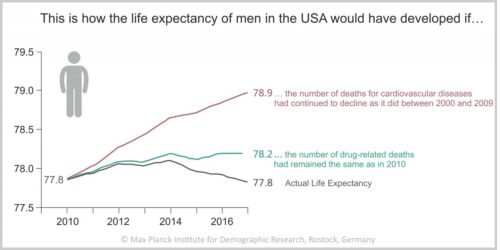
18 Mar Main Cause of US Lifespan Stagnation Not Opioids
MedicalResearch.com Interview with:
Mikko Myrskylä PhD
Executive Director, Max Planck Institute for Demographic Research
Professorial Research Fellow,
London School of Economics Professor of Social Statistics
University of Helsinki
MedicalResearch.com: What is the background for this study?
Response: Life expectancy in the U.S. increased at a phenomenal pace throughout the twentieth century, by nearly two years per decade. After 2010, however, U.S. life expectancy growth stalled and has most recently been declining. A critical question for American health policy is how to return U.S. life expectancy to its pre-2010 growth rate. Researchers and policy makers have focused on rising drug-related deaths in their search for the explanations for the stalling and declining life expectancy.
MedicalResearch.com: What are the main findings?
Response: Our new study shows that a stagnating decline in cardiovascular disease (CVD) mortality was the main culprit for the end of life expectancy improvements, outpacing and overshadowing the effects of all other causes of death. Comparisons with other high-income countries reveal that the U.S. CVD stagnation is unusually strong, contributing to a stark mortality divergence between the U.S. and peer nations.

CAPTION
The figure displays the results of a simulation that examines the size of the influence of each of the two causes of death. The simulation shows how the life expectancy of 25-year-old American men would have developed between 2010 and 2017 if the number of drug-related deaths had remained constant, and how it would have developed if the number of deaths from cardiovascular diseases had declined to the same extent as it did between 2000 and 2009. (The simulation calculates the remaining life expectancy of 25-year-olds; in the figure, these 25 years are added to the total life expectancy.)
CREDIT: MPIDR
MedicalResearch.com: What should readers take away from your report?
Response: While increasing drug-related mortality is a major American crisis, it is not the main reason for why life expectancy has stopped increasing. Instead, the fact that cardiovascular disease mortality is not continuing to decline as it did in the past is the main reason. U.S. life expectancy increased over the past decades to large extent thanks to declining cardiovascular disease mortality. Without the aid of further cardiovascular disease mortality declines, future U.S. life expectancy gains must come from other causes—a monumental task given the enormity of earlier declines in cardiovascular disease death rates. Reversal of the drug overdose epidemic will be beneficial, but insufficient for achieving pre-2010 pace of life expectancy growth.
MedicalResearch.com: What recommendations do you have for future research as a result of this work?
Response: Americans have enjoyed robust gains in life expectancy for more than a generation. A persistent stagnation in U.S. life expectancy would require social, economic, and political institutions to adapt. The opioid epidemic has clearly contributed to recent stagnation. We do not wish to diminish its importance. The troubling trend in U.S. CVD mortality, however, is the main culprit for longer-term U.S. life expectancy stagnation.
Uncovering the reasons behind stalling CVD mortality should be a research priority. Rising obesity is a worthy candidate. The U.S. obesity epidemic started in the mid-1980s, ahead of other high-income countries. Recent cohorts have experienced obesity at a younger age than their predecessors. Moreover, the U.S. has a higher prevalence of diabetes compared to its peer countries. The timing of the cigarette smoking epidemic and particularly its recession may also be important. The U.S. was a leader in both the rise and fall of the smoking epidemic and the U.S. may have already benefitted from most of the gains from declining smoking. European countries, in contrast, may still be enjoying robust mortality benefits from their more recent declines.
No disclosures
Citation:
US life expectancy stalls due to cardiovascular disease, not drug deaths
Neil K. Mehta, Leah R. Abrams, Mikko Myrskylä
Proceedings of the National Academy of Sciences Mar 2020, 201920391; DOI: 10.1073/pnas.1920391117
https://www.pnas.org/content/early/2020/03/10/1920391117
[subscribe]
[last-modified]
The information on MedicalResearch.com is provided for educational purposes only, and is in no way intended to diagnose, cure, or treat any medical or other condition. Always seek the advice of your physician or other qualified health and ask your doctor any questions you may have regarding a medical condition. In addition to all other limitations and disclaimers in this agreement, service provider and its third party providers disclaim any liability or loss in connection with the content provided on this website.
Last Updated on March 18, 2020 by Marie Benz MD FAAD
